国际商务谈判International Negotiation
- 格式:doc
- 大小:86.00 KB
- 文档页数:4

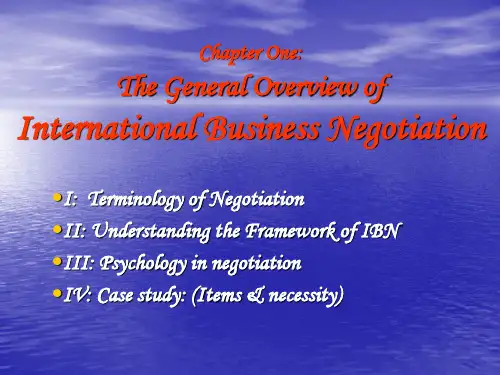
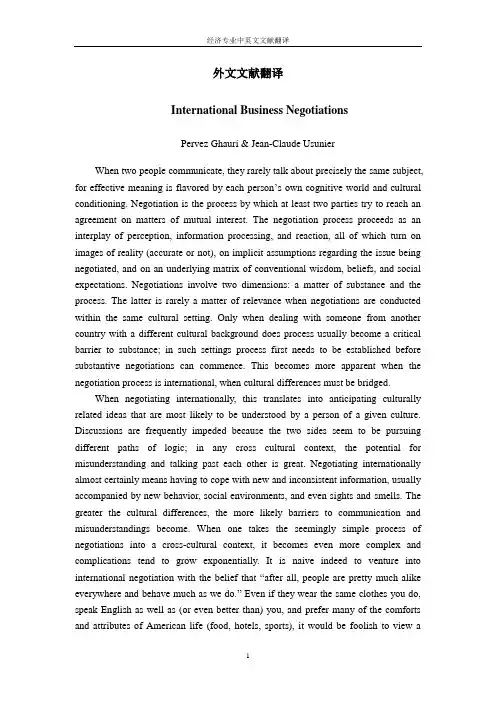
外文文献翻译International Business NegotiationsPervez Ghauri & Jean-Claude UsunierWhen two people communicate, they rarely talk about precisely the same subject, for effective meaning is flavored by each person’s own cognitive world and cultural conditioning. Negotiation is the process by which at least two parties try to reach an agreement on matters of mutual interest. The negotiation process proceeds as an interplay of perception, information processing, and reaction, all of which turn on images of reality (accurate or not), on implicit assumptions regarding the issue being negotiated, and on an underlying matrix of conventional wisdom, beliefs, and social expectations. Negotiations involve two dimensions: a matter of substance and the process. The latter is rarely a matter of relevance when negotiations are conducted within the same cultural setting. Only when dealing with someone from another country with a different cultural background does process usually become a critical barrier to substance; in such settings process first needs to be established before substantive negotiations can commence. This becomes more apparent when the negotiation process is international, when cultural differences must be bridged.When negotiating internationally, this translates into anticipating culturally related ideas that are most likely to be understood by a person of a given culture. Discussions are frequently impeded because the two sides seem to be pursuing different paths of logic; in any cross cultural context, the potential for misunderstanding and talking past each other is great. Negotiating internationally almost certainly means having to cope with new and inconsistent information, usually accompanied by new behavior, social environments, and even sights and smells. The greater the cultural differences, the more likely barriers to communication and misunderstandings become. When one takes the seemingly simple process of negotiations into a cross-cultural context, it becomes even more complex and complications tend to grow exponentially. It is naive indeed to venture into international negotiation with the belief that “after all, people are pretty much alike everywhere and behave much as we do.” Even if they wear the same clothes you do, speak English as well as (or even better than) you, and prefer many of the comforts and attributes of American life (food, hotels, sports), it would be foolish to view amember of another culture as a brother in spirit. That negotiation style you use so effectively at home can be ineffective and inappropriate when dealing with people from another cultural background; in fact its use can often result in more harm than gain. Heightened sensitivity, more attention to detail, and perhaps even changes in basic behavioral patterns are required when working in another culture.Members of one culture may focus on different aspects of an agreement (e.g., legal, financial) than may members of another culture (personal, relationships). The implementation of a business agreement may be stressed in one culture, while the range and prevention of practical problems may be emphasized in another culture. In some cultures, the attention of people is directed more toward the specific details of the agreement (documenting the agreement), while other cultures may focus on how the promises can be kept (process and implementation). Americans negotiate a contract; the Japanese negotiate a personal relationship. Culture forces people to view and value differently the many social interactions inherent in fashioning any agreement. Negotiations can easily break down because of a lack of understanding of the cultural component of the negotiation process. Negotiators who take the time to understand the approach that the other parties are likely to use and to adapt their own styles to that one are likely to be more effective negotiators.American and Russian people are not similar; their ethical attitudes do not coincide: they evaluate behavior differently. What an American may consider normative, positive behavior (negotiating and reaching a compromise with an enemy), a Russian perceives as showing cowardice, weakness, and unworthiness; the word “deal”has a strong negative connotation, even today in contemporary Russia. Similarly, for Russians, compromise has negative connotation; principles are supposed to be inviolable and compromise is a matter of integrity (The Russians are not alone here: a Mexican will not compromise as a matter of honor, dignity, and integrity; likewise, an Arab fears loss of manliness if he compromises.) A negotiation is treated as a whole without concessions. At the Strategic Arms Limitation Talks (SALT) talks, the Americans thought they had an agreement (meaning conclusive commitment), while the Russians said it was an understanding (meaning an expression of mutual viewpoint or attitude). When the Americans thought they had an understanding, the Russians said it was a procedural matter, meaning they had agreed to a process for conducting the negotiation. Different cultural systems can produce divergent negotiating styles--styles shaped by each nation’s culture, geography, history, and political system. Unless you see the world through the other’s eyes (nomatter how similar they appear to you), you may not be seeing or hearing the same. No one can usually avoid bringing along his or her own cultural assumptions, images, and prejudices or other attitudinal baggage into any negotiating situation. The way one succeeds in cross cultural negotiations is by fully understanding others, using that understanding to one’s own advantage to realize what each party wants from the negotiations, and to turn the negotiations into a win-win situation for both sides. A few potential problems often encountered during a cross-cultural negotiation include ( Frank, 1992):Insufficient understanding of different ways of thinking.Insufficient attention to the necessity to save face.Insufficient knowledge of the host country--including history, culture, government, status of business, image of foreigners.Insufficient recognition of political or other criteria.Insufficient recognition of the decision-making process.Insufficient understanding of the role of personal relations and personalities.Insufficient allocation of time for negotiations.Over two-thirds of U.S.-Japanese negotiation efforts fail even though both sides want to reach a successful business agreement (The U.S. Department of Commerce is even more pessimistic; it estimates that for every successful American negotiation with the Japanese, there are twenty-five failures.) In fact, these numbers hold true for most cross-cultural meetings. Often barriers to a successful agreement are of a cultural nature rather than of an economical or legal nature. Since each side perceives the other from its own ethnocentric background and experience, often neither side fully comprehends why the negotiations failed. It is precisely this lack of knowledge concerning the culture and the “alien” and “unnatural” expectations of the other side that hinders effective negotiation with those from another culture.In cross-cultural negotiations, many of the rules taught and used domestically may not apply--especially when they may not be culturally acceptable to the other party. For most Western negotiators this includes the concepts of give and take, of bargaining, and even of compromise. The stereotypical, common Western ideal of a persuasive communicator--highly skilled in debate, able to overcome objections with verbal flair, an energetic extrovert--may be regarded by members of other cultures as unnecessarily aggressive, superficial, insincere, even vulgar and repressive. To other Americans, the valued American traits of directness and frankness show evidence of good intentions and personal convictions. To an American it is complimentary to becalled straightforward and aggressive. This is not necessarily so, however, for members of other cultures. To describe a person as “aggressive”is a derogatory characterization to a British citizen. To the Japanese, those very same traits indicate lack of confidence in one’s convictions and insincerity. Instead, terms such as thoughtful, cooperative, considerate, and respectful instill positives in the Japanese and many Asian cultures.Domestically, the study of negotiation tends to encompass business relationships between parties, tactics, bargaining strategies, contingency positions, and so on. However, in a cross-cultural context, besides the usual rules of negotiation, one has to be wary of fine nuances in relationships and practices and how they are perceived and executed by members of the other culture. The two business negotiators are separated from each other not only by physical features, a totally different language, and business etiquette, but also by a different way to perceive the world, to define business goals, to express thinking and feeling, to show or hide motivation and interests. From the other party’s perspective, for example, to some cultures Americans may appear aggressive and rude, while to others, those very same Americans appear calm and uninterested.1 The Art of NegotiationsThe word “negotiations”stems from the Roman word negotiari meaning “to carry on business” and is derived from the Latin root words neg (not) and otium (ease or leisure). Obviously it was as true for the ancient Romans as it is for most businesspersons of today that negotiations and business involves hard work. A modern definition of negotiation is two or more parties with common (and conflicting) interests who enter into a process of interaction with the goal of reaching an agreement (preferably of mutual benefit). John Kenneth Galbraith said “Sex apart, negotiation is the most common and problematic involvement of one person with another, and the two activities are not unrelated.” Negotiations are a decision-making process that provides opportunities for the parties to exchange commitments or promises through which they will resolve their disagreements and reach a settlement.A negotiation is two or more parties striving to agree when their objectives do not coincide.Negotiation consists of two distinct processes: creating value and claiming value. Creating value is a cooperative process whereby the parties in the negotiation seek to realize the full potential benefit of the relationship. Claiming value is essentially a competitive process. The key to creating value is finding interests that the parties havein common or that complement each other, then reconciling and expanding upon these interests to create a win-win situation. Parties at the negotiating table are interdependent. Their goals are locked together. A seller cannot exist without a buyer. The purpose of a negotiation is a joint decision-making process through which the parties create a mutually acceptable settlement. The objective is to pursue a win-win situation for both parties.Negotiations take place within the context of the four Cs: common interest, conflicting interests, compromise, and criteria (Moran and Stripp, 1991). Common interest considers the fact that each party in the negotiation shares, has, or wants something that the other party has or does. Without a common goal, there would be no need for negotiation. Conflict occurs when people have separate but conflicting interests. Areas of conflicting interests could include payment, distribution, profits, contractual responsibilities, and quality. Compromise involves resolving areas of disagreement. Although a win-win negotiated settlement would be best for both parties, the compromises that are negotiated may not produce the result. The criteria include the conditions under which the negotiations take place. The negotiation process has few rules of procedure. Rules of procedure are as much a product of negotiation as the issues. Over time, the four Cs change and the information, know-how, and alternatives available to the negotiating international company and the host country also change, resulting in a fresh interpretation of the four Cs, the environment, and the perspective. In essence, negotiation takes place within the context of the political, economic, social, and cultural systems of a country. The theory of the negotiation process includes the following dimensions: (1) bargainer characteristics, (2) situational constraints, (3) the process of bargaining, and (4) negotiation outcomes. This theory is based on actors who share certain values and beliefs based on their culture. These actors function in business and economic situations that also have cultural influences, and they act in certain culturally inscribed ways. We bargain when:1. A conflict of interest exists between two or more parties; that is, what is, whatone wants is not necessarily what the other one wants.2. A fixed or set of rules or procedures for resolving the conflict does not exist,or the parties prefer to work outside of a set of rules to invent their own solution to the conflict.3. The parties, at least for the moment, prefer to search for agreement rather thanto fight openly, to have one side capitulate, to permanently break off contact, or to take their dispute to a higher authority to resolve it.In summary, negotiations primarily consists of five aspects: (1) goals: motivating the parties to enter; (2) the process of negotiating that involves communications and actions; (3) outcomes; (4) preexisting background factors of cultural traditions and relations; and (5) specific situational conditions under which the negotiation is conducted.2 VerbalLanguage is highly important. When people from different cultures communicate, culture-specific factors affect how they encode and decode their messages. Negotiators should check understanding periodically, move slowly, use questions liberally, and avoid slang and idioms. Even the discussion of negotiation, compromise, and agreement has different meanings to different cultures. Both the American and Korean meanings for the word “corruption”are negative; however in the United States, the word connotes being morally wrong while for the Koreans it implies being socially unfortunate. The Mexican will not compromise as a matter of honor, dignity, and integrity. The Arab fears loss of manliness if he compromises. In Russia, compromise has a negative connotation; principles are supposed to be inviolable and compromise is a matter of integrity. For Russians, a negotiation is treated as a whole without concessions.In the American culture, those who refuse to bargain are viewed as cold, secretive, and not really serious about conducting business. The Dutch are not hagglers; you should make your offer fairly close to your true asking price; if you start making large concessions you will lose their confidence. The Swedes are methodical, detailed individuals who are slow to change positions. Bargaining is not highly valued in Swedish culture; those who bargain, who attempt to negotiate by offering a higher price in order to concede to a lower price, can be viewed as untrustworthy, inefficient, or perhaps out for personal gain at the expense of others.3 Nonverbal Communications in Cross-Cultural NegotiationsNonverbal behavior may be defined as any behavior, intentional or unintentional, beyond the words themselves that can be interpreted by a receiver as having meaning. Nonverbal behaviors could include facial expressions, eye contact, gestures, body movements, posture, physical appearance, space, touch, and time usage. They are all different from culture to culture. Nonverbal behaviors either accompany verbalmessages or are used independently of verbal messages. They may affirm and emphasize or negate and even contradict spoken messages. Nonverbal behaviors are more likely to be used unconsciously and spontaneously because they are habitual and routine behaviors.The wide range of behaviors called nonverbal behavior can be divided into seven categories. Gestures, body movement, facial movement, and eye contact are combined in the kinesic code commonly called body language. Vocalics refers to call vocal activity other than the verbal context itself. Also called paralanguage, vocalics includes tone, volume, and sounds that are not words. Behaviors that involve touching are placed in the haptics code. The use of space is called proxemics, and the use of time is chronemics. Physical appearance includes body shape and size, as well as clothing and jewelry. Finally, artifacts refer to objects that are associated with a person, such as one’s desk, car, or books. It should be emphasized that these codes do not usually function independently or sequentially; rather, they work simultaneously. In addition, nonverbal behavior is always sending messages; we can not communicate without using them, although, at times, the messages may be ambiguous. This wide range of nonverbal behaviors serves various functions in all face-to-face encounters. Most important, emotional messages at the negotiating table are expressed nonverbally by gestures, tone of voice, or facial expressions. The other side’s interpretation of your statement depends on the nonverbal more than what was actually said. Nonverbal communications is significant.From: International Business Negotiations, 2001国际商务谈判伯维茨.高利, 简.科劳德.阿斯尼尔当两个人交流时,他们很少精确地谈论相同的问题,因为实际的意思会受到每个人认知的世界和文化熏陶的影响。
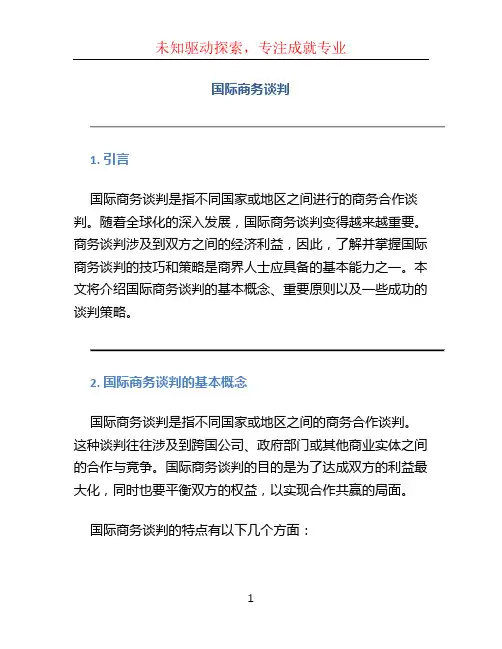
国际商务谈判1. 引言国际商务谈判是指不同国家或地区之间进行的商务合作谈判。
随着全球化的深入发展,国际商务谈判变得越来越重要。
商务谈判涉及到双方之间的经济利益,因此,了解并掌握国际商务谈判的技巧和策略是商界人士应具备的基本能力之一。
本文将介绍国际商务谈判的基本概念、重要原则以及一些成功的谈判策略。
2. 国际商务谈判的基本概念国际商务谈判是指不同国家或地区之间的商务合作谈判。
这种谈判往往涉及到跨国公司、政府部门或其他商业实体之间的合作与竞争。
国际商务谈判的目的是为了达成双方的利益最大化,同时也要平衡双方的权益,以实现合作共赢的局面。
国际商务谈判的特点有以下几个方面:•第一,双方涉及着不同的法律、文化、商业习俗和经济环境,谈判双方需要了解和尊重对方的差异性。
•第二,国际商务谈判往往涉及到复杂的经济利益,对双方的谈判技巧和策略要求较高。
•第三,国际商务谈判需要更多的时间和精力投入,需要双方在谈判过程中进行多轮的讨论和协商。
3. 国际商务谈判的重要原则在国际商务谈判中,有一些重要的原则需要遵循,以确保谈判的顺利进行和达成双方的利益最大化。
下面是一些重要的原则:3.1 互利共赢原则互利共赢原则是指在谈判过程中,双方应该以寻求双赢的方式进行合作,而不是以竞争和对抗的方式进行谈判。
双方应该合作、互相尊重和信任对方,以达成双方的利益最大化。
3.2 公平原则公平原则是指在谈判过程中,双方应该遵守公平的原则,不偏袒任何一方。
谈判双方应该平等地对待和尊重对方的权益,遵循公正的原则。
3.3 合法合规原则合法合规原则是指在谈判过程中,双方应该遵守国际法、国家法律和商业规则。
谈判双方应该遵循合法的原则,以确保谈判的合法性和合规性。
3.4 透明公开原则透明公开原则是指在谈判过程中,双方应该保持透明和公开的原则。
谈判双方应该及时向对方提供信息和数据,以确保谈判的透明度和可预测性。
4. 国际商务谈判的成功策略在国际商务谈判中,有一些成功的策略可以帮助双方达成合作共赢的目标。




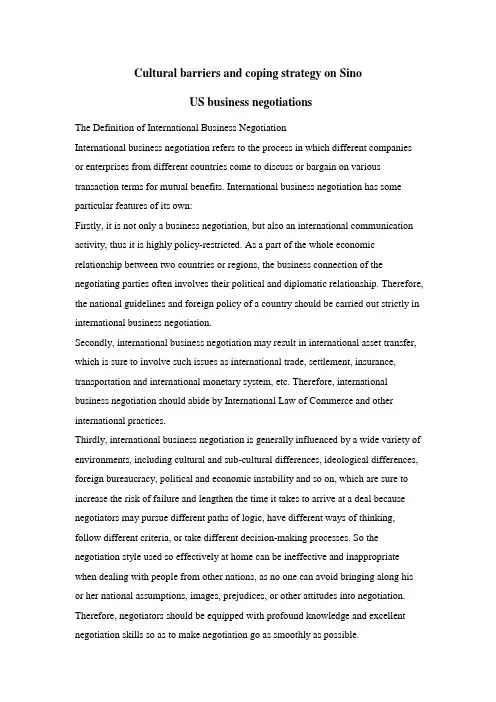
Cultural barriers and coping strategy on SinoUS business negotiationsThe Definition of International Business NegotiationInternational business negotiation refers to the process in which different companies or enterprises from different countries come to discuss or bargain on various transaction terms for mutual benefits. International business negotiation has some particular features of its own:Firstly, it is not only a business negotiation, but also an international communication activity, thus it is highly policy-restricted. As a part of the whole economic relationship between two countries or regions, the business connection of the negotiating parties often involves their political and diplomatic relationship. Therefore, the national guidelines and foreign policy of a country should be carried out strictly in international business negotiation.Secondly, international business negotiation may result in international asset transfer, which is sure to involve such issues as international trade, settlement, insurance, transportation and international monetary system, etc. Therefore, international business negotiation should abide by International Law of Commerce and other international practices.Thirdly, international business negotiation is generally influenced by a wide variety of environments, including cultural and sub-cultural differences, ideological differences, foreign bureaucracy, political and economic instability and so on, which are sure to increase the risk of failure and lengthen the time it takes to arrive at a deal because negotiators may pursue different paths of logic, have different ways of thinking, follow different criteria, or take different decision-making processes. So the negotiation style used so effectively at home can be ineffective and inappropriate when dealing with people from other nations, as no one can avoid bringing along his or her national assumptions, images, prejudices, or other attitudes into negotiation. Therefore, negotiators should be equipped with profound knowledge and excellent negotiation skills so as to make negotiation go as smoothly as possible.。
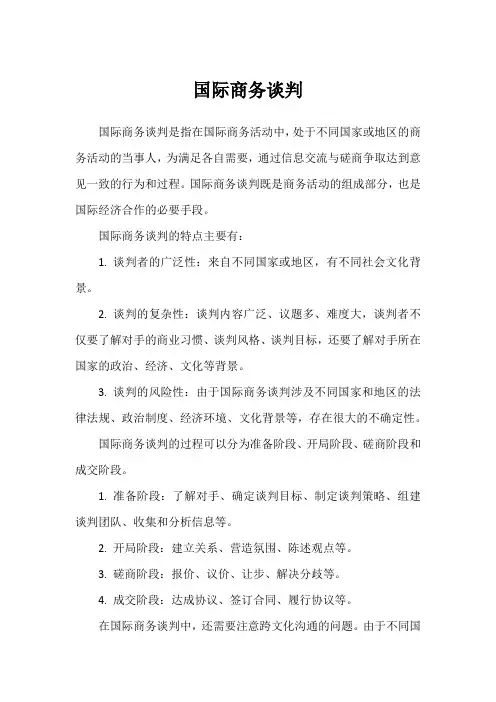
国际商务谈判
国际商务谈判是指在国际商务活动中,处于不同国家或地区的商务活动的当事人,为满足各自需要,通过信息交流与磋商争取达到意见一致的行为和过程。
国际商务谈判既是商务活动的组成部分,也是国际经济合作的必要手段。
国际商务谈判的特点主要有:
1. 谈判者的广泛性:来自不同国家或地区,有不同社会文化背景。
2. 谈判的复杂性:谈判内容广泛、议题多、难度大,谈判者不仅要了解对手的商业习惯、谈判风格、谈判目标,还要了解对手所在国家的政治、经济、文化等背景。
3. 谈判的风险性:由于国际商务谈判涉及不同国家和地区的法律法规、政治制度、经济环境、文化背景等,存在很大的不确定性。
国际商务谈判的过程可以分为准备阶段、开局阶段、磋商阶段和成交阶段。
1. 准备阶段:了解对手、确定谈判目标、制定谈判策略、组建谈判团队、收集和分析信息等。
2. 开局阶段:建立关系、营造氛围、陈述观点等。
3. 磋商阶段:报价、议价、让步、解决分歧等。
4. 成交阶段:达成协议、签订合同、履行协议等。
在国际商务谈判中,还需要注意跨文化沟通的问题。
由于不同国
家和地区的文化背景、价值观、社会习俗等存在差异,可能会导致沟通障碍和误解。
因此,谈判者需要了解并尊重对手的文化差异,采取适当的沟通策略和技巧,以确保谈判的顺利进行。
总之,国际商务谈判是一项复杂而重要的任务,需要谈判者具备丰富的知识和经验,以及良好的跨文化沟通能力。
通过有效的谈判策略和技巧,可以达成互利共赢的协议,促进国际经济合作的发展。

1 中文4495字 外文文献翻译
International Business Negotiations Pervez Ghauri & Jean-Claude Usunier When two people communicate, they rarely talk about precisely the same subject, for effective meaning is flavored by each person’s own cognitive world and cultural conditioning. Negotiation is the process by which at least two parties try to reach an agreement on matters of mutual interest. The negotiation process proceeds as an interplay of perception, information processing, and reaction, all of which turn on images of reality (accurate or not), on implicit assumptions regarding the issue being negotiated, and on an underlying matrix of conventional wisdom, beliefs, and social expectations. Negotiations involve two dimensions: a matter of substance and the process. The latter is rarely a matter of relevance when negotiations are conducted within the same cultural setting. Only when dealing with someone from another country with a different cultural background does process usually become a critical barrier to substance; in such settings process first needs to be established before substantive negotiations can commence. This becomes more apparent when the negotiation process is international, when cultural differences must be bridged. When negotiating internationally, this translates into anticipating culturally related ideas that are most likely to be understood by a person of a given culture. Discussions are frequently impeded because the two sides seem to be pursuing different paths of logic; in any cross cultural context, the potential for misunderstanding and talking past each other is great. Negotiating internationally almost certainly means having to cope with new and inconsistent information, usually accompanied by new behavior, social environments, and even sights and smells. The greater the cultural differences, the more likely barriers to communication and misunderstandings become. When one takes the seemingly simple process of negotiations into a cross-cultural context, it becomes even more complex and complications tend to grow exponentially. It is naive indeed to venture into international negotiation with the belief that “after all, people are pretty much alike everywhere and behave much as we do.” Even if they wear the same clothes you do, 2
国际商务谈判国际商务谈判是指不同国家之间进行的商业交流和合作的活动。
在全球化的今天,国际商务谈判已经成为各国企业发展的重要手段。
本文将主要讨论国际商务谈判的过程和技巧,并以一个具体案例进行分析。
一、国际商务谈判的过程国际商务谈判的过程一般分为准备阶段、交流阶段、协议阶段和履约阶段。
准备阶段是谈判的第一步,它包括了解对方的国情、市场情况、企业概况等,还要制定谈判目标、策略和计划。
在这个阶段,企业还要进行内部准备,比如确定谈判团队和角色分工、收集和分析信息等。
交流阶段是谈判的核心阶段,它主要包括双方进行信息交换、讨论问题、提出建议和解决分歧。
在交流阶段,有效的沟通和良好的人际关系至关重要。
谈判团队应该具备良好的沟通能力和谈判技巧,并且要善于掌握时机和方式,以达到谈判目标。
协议阶段是指双方达成共识,并签署正式协议的阶段。
在这个阶段,双方需要就相关条款进行详细商讨,以确保协议的有效性和可操作性。
此外,法律和合规性的考虑也是协议阶段的重要内容。
履约阶段是谈判的最后一步,也是对协议内容的履行和落实阶段。
在履约阶段,双方应该按照协议的约定进行实际操作,并及时解决可能出现的问题和纠纷。
二、国际商务谈判的技巧1. 目标明确:在准备阶段,企业应该明确自己的谈判目标,并考虑对方的目标和利益。
只有明确目标,才能制定相应的策略和计划。
2. 信息收集:在准备阶段,企业要充分了解对方的情况,包括文化、法律、经济等方面的信息。
这样不仅有助于理解对方的需求和利益,还能帮助企业在谈判中做出正确的决策。
3. 有效沟通:好的沟通是谈判成败的关键。
谈判团队应该具备良好的口头表达和听取能力,善于倾听对方的观点和诉求,并以积极的态度进行回应。
双方应该相互尊重,理解对方的立场和利益,以达到双赢的目标。
4. 灵活应变:在谈判过程中,双方可能会出现各种问题和意外情况。
企业应该具备灵活应变的能力,及时调整策略和计划,并且要根据实际情况做出正确的决策。
西京学院本科毕业设计(论文)外文资料翻译教学单位:经济系专业:国际经济与贸易(本)学号:0700090641姓名:王欢外文出处:《国际商务谈判》附件:1.译文;2.原文;3.评分表2010年11月1.译文译文(一)国际商务谈判是国际商务活动中,处于不同国家或不同地区的商务活动当事人为了达成某笔交易,彼此通过信息交流,就交易的各项要件进行协商的行为过程。
可以说国际商务谈判是一种在对外经贸活动中普遍存在的﹑解决不同国家的商业机构之间不可避免的利害冲突﹑实现共同利益的一种必不可少的手段。
国际商务谈判与一般贸易谈判具有共性,即以经济利益为目的,以价格为谈判核心。
因为价格的高低最直接﹑最集中的表明了谈判双方的利益切割,而且还由于谈判双方在其他条件,诸如质量﹑数量﹑付款形式﹑付款时间等利益要素上的得与失,在很多情况下都可以折算为一定的价格,并通过价格的升降而得到体现或予以补偿。
在国际买卖合同中价格术语包括单价和总价。
单价则是由计量单位,单价,计价货币以及贸易术语构成。
例如,一个价格术语可以这样来说:“每吨CIF伦敦1500美元包含3%佣金”。
总价格是合同中交易的总额。
在谈判过程中,应该由谁先出价,如何回应对方的报价,做出多少让步才适当,到最后双方达成都能接受的协议,整个这一过程被称之为谈判之舞。
通常情况下,谈判者的目标价位不会有重叠:卖方想为自己的产品或服务争取的价格,会高出买方愿意付出的价格。
然而,有时候谈判者的保留点却会相互重叠,也就是说大多数买方愿意付出的价格都会高于卖方可以接受的最低价格,在这种议价区间的前提下,谈判的最终结果会落在高于卖方的保留点而低于买方的保留点之间的某个点上。
议价区间可以为正数,也可以为负数。
在正议价区间,谈判者的保留点会互相重叠的,即买方愿意出的最高价格高于卖方可以接受的最低价格。
这意味着谈判者能达成协议的话,那么结果肯定在这个区间之内。
负议价区间可能根本不存在或是负数,这可能会造成花费巨大的时间来做一件毫无结果的协议,谈判者将会浪费时间成本。
CATALOGUEThe General Overview on International Business NegotiationThe General Procedures of International Business NegotiationFive Links of International Business NegotiationCross-Cultural Problems in International Business NegotiationBasic Qualities for NegotiatorsSome Styles in International Business NegotiationTactical Expressions in Business NegotiationPreparation for ExportingPreparation for NegotiationBusiness Negotiation IBusiness Negotiation IIBusiness Negotiation IIIBusiness Negotiation IVAfter the NegotiationChapter Onee GTheneral Overview on International Business NegotiationAn Overall Framework of International Business NegotiationFeatures of International Business NegotiationBasic Rules of International Business NegotiationStock PhrasesSome Tips for Trade Delegation1.What is Negotiation?The word “negotiation” derives from the Latin Infinitive “negotiari”(做贸易或生意)which means “to trade or do business”. This word itself is from another word, “negare”(拒绝), meaning “ to deny” and a noun, otium(休闲), meaning “leisure”. Thus , the ancient Roman businessperson would “deny leisure” until the business has been settl ed. Negotiation is a common human activity as well as a process that people undertake everyday to manage their relationships such a buyer and a seller, a husband and wife, children and parents. As the stakes in some of these negotiations are not very high, people need not have to get preparations for the process and the outcome. But in international business negotiations, the stakes are usually high, people cannot ignore this fact, they have to get preplans in a more careful way. Both parties in this kind of negotiation should contact each other so that they can get a better deal rather than simply accepting or rejecting what the other is offering. The whole process of negotiation is based upon the premise that both parties are interdependent, that is, one side cannot get what he/she wants without taking the other into consideration. In the process of negotiation, there are no rules, tradition, rational methods or higher authorities available to resolve their conflict once it crops up. Negotiation is a voluntary process of giving and taking where both parties amend their offers and modify their expectations so as to come closer to each other and they can quit, at any time.2. Why do People Negotiate?Negotiation is at the heart of every transaction and, for the most part, it comes down to theinteraction between two sides with a common goal (profits) but divergent methods. These methods (the details of the contract) must be negotiated to the satisfaction of both parties. As we will see later that it can be a very trying process that is full of confrontation and concession. Whether it is trade or investment, one party will always arrive at the negotiation table in a position of greater power. That power ( the potential for the profits ) may derive from the extent of the demand or from the ability to supply. The purpose of negotiation is to redistribute that potential. There is no such thing as “to take it or leave it” in international business. In fact, everything is negotiable. It all depends on the expertise of the negotiators.3. An Overall Framework of IBNInternational business negotiation (IBN) is a consultative process between governments, trade organizations, multinational enterprises, private business firms and buyers and sellers in relation to investment and import and export of products, machinery and equipments and technology. Negotiation is one of the important steps taken towards completing import and export trade agreements.To reach the desired results, the negotiators must seriously carry out the relative trade policies of their own countries. They should have good manners and speak fluent English. They should have a profound knowledge of professional technology and international markets. They should know the specifications, packing, features and advantages of the products and be able to use idiomatic and professional terms. In general, an overall framework of international business negotiation cover the following aspects: background factors, the atmosphere and the process.3.1 Background factors refer to objectives, environment, markets position, third parties and negotiators. They influence the process of negotiation and the atmosphere in a positive or negative way. Objectives mean what each side desires to achieve in the end. They are common, conflicting or complementary interests in both sides‟ wanting a successful transaction to take place; their interests conflict as profit to one is cost to the other; and complementary interest brings them together. Common and complementary objectives leave direct and positive effects while conflicting objectives have negative ones on the negotiation process. Environment here is defined as the political, social and structural factors related to both parties. It often hinders the process in international negotiation. Political and social aspects can affect the process whereas market structure does the atmosphere. The market position of the parties involved plays a leading role in the negotiation process. The third parties such as governments, brokers, consultants and so on may influence the process with their own objectives. Negotiators affect the negotiating process by means of their own experience and negotiating skills.3.2 The atmosphere is of great importance to the whole process of the international business negotiation. The atmosphere and the process influence each other at each stage. Atmosphere refers to the perceived “milieu”(氛围) around the interaction, how each party regards the other‟s behavior, and the properties of the process. It has to do with people‟s perception of reality. To be more exact, in negotiation it is the perception of reality that is far more important than the reality itself. Some characteristics of the atmosphere are dominant at one stage; others at other stage. For example, cooperation is dominant at the pre-negotiation rather than conflict, as both sides look formutual solutions. Different characteristics of atmosphere dominate from process to process. These characteristics are classified as conflict vs cooperation, power vs dependence and expectations. The existence of conflict and cooperation is a fundamental characteristic of the negotiation process. On one hand, both sides have some common interests in finding a solution to the problem that fits them both. On the other hand, a conflict of interest may arise, as cost to one can mean income to the other. The relation between power and dependence is closely related to the actual power relation, which is affected by the value of the relationship to the sides and their available alternatives. As for expectations, there are two types: long-term expectations with respect to the possibilities and values of future business; short-term expectations regarding prospects for the present deal. Expectations develop and change in different stages of the process.3.3 The process of international business negotiation is made up of the three different stages. A stage is defined as a specific part of the process and covers all actions and communications by either side pertaining (relevant) to negotiations made during that part. Either side communicates with the other to exchange information within each stage. A specific stage comes to an end with where both sides decide to proceed on to the next stage or decide to abandon the communication if they see no point in further negotiations. The three different stages are: pre-negotiation, face-to face-negotiation and post-negotiation.3.3.1 The pre-negotiation stage starts from the first contact between the two sides whose interest in doing business with each other is shown. From this stage on, both sides begin to understand one another‟s needs and evaluate the benefits of enterin g into the process of negotiation. This stage is more usually important than the formal negotiations in the international business relationship. Social and informal relationships between negotiators, trust and confidence in each other are of great help. Both sides now also start to form their strategy for face-to-face negotiation as well as try to foresee and take precautions against possible events.3.3.2 At Face-to-face stage, both sides know that they can work together for a solution to a joint problem in spite of that the fact that each side may view the situation in its own way. This indicates the importance of having face-to-face negotiation in an open-minded way and getting ready several alternatives. It is time for both sides to explore the differences in preferences and expectations so that they can come closer to each other. Generally, the negotiation process is controlled by the side that has arranged the agenda, for in the process, he can stress his own strengths and the opponent‟s weaknesses, thus putting the other side on the defensive. However, the agenda may reveal the preparing side‟s position in advance and hence permit the other side to prepare its countermeasures. Some people prefer to start negotiations by discussing and agreeing on broad principles. Another way to ensure success at this stage is an initial discussion on items of common interest, which can help create an atmosphere of cooperation between both sides. As for the choice of strategy, it depends on3.3.3 All the terms and conditions at this(Post-Negotiation ) stage have been agreed upon with the contract being drawn up to be signed. What is worth noticing is that writing the contact and thewording in it is a negotiation process in itself, for meaning and values may be different between both sides. This stage may lead to a renewed face-to-face negotiation if there is negative feedback from background factors and atmosphere. Therefore, the terms and conditions agreed upon should be read to each other after concessions are exchanged and discussions be held by means of minutes of meetings, or something unpleasant and unexpected may arise later on in the course of the implementation of the contract unless both sides make sure that they have paid enough attention to every detail. It is necessary that both sides should make sure that they understand everything they have agreed on before they leave the negotiation table.4. Three Targets of International Business NegotiationFor a successful agreement, participants need to know negotiation principles and tactics. There are two principles in international business negotiations. First, at the beginning of the negotiation, the negotiators should know well their desired results and not be willfully manipulated by their counterparts. Only with a definite purpose will the negotiators grasp the key to the negotiation and realize their expected purpose. Second, negotiators need to put forward what they expect, take a firm stand and make clear their position.In international business negotiations, price is usually the key point because it directly concerns the economic benefits to both sides. Both sides seek a desired result.To get the expected result or achieve a certain purpose, the negotiators, should calculate carefully and decide three different targets: 1) the best target; 2) the intermediate target; 3) the acceptable target4.1 The best target is to achieve all desired results. You should know well whether your first quotation is high or low if it is generally accepted by your counterpart. Usually both sides have a few bargains before acceptance. In the beginning, make a high offer and negotiate for the best target. Generally speaking, persons who firmly maintain the desired objectives to the end can obtain the best deal.4.2 The intermediate target is fair for both sides, although slightly lower than the best target. Don‟t begin negotiating at too low of a price. Your quotation is to be a little lower each time. Do it step by step. Each time you reduce the price, you should remain serious about the desired results. Under this situation, your counterpart may well accept your quotation as the best possible price. It is likely that you may reach an agreement at this price. Please keep in mind that taking a serious and firm attitude is the key to avoiding further price reductions and unnecessary expenses. This will result in increased profits. If you meet with negotiators who always bargain using harsh language, do not be angry. This indicates that they want to buy your products. You should be patient and friendly, using soft words and moderate speaking speed and tone, knowing well what not to say, what to say and when to say. When you feel in danger of going into a deadlocked negotiation, it is suggested to request a break or rest. Then readjust your plan and continue the negotiation.4.3 The acceptable target is the minimum level both sides can bear. It should not be exposed to your counterpart at the beginning of the negotiation. Your counterpart may not believe it andalthough the price is the lowest, he may reject your quotation. On the other hand, even if the agreement is reached at the minimum acceptable price, your counterpart may not have a satisfactory sense of having brought your price down…In brief, t he purpose of the negotiation is to arrive at an agreement to both sides‟ advantage. The successful results of the negotiations depend on the determined objectives, perseverance and the language expressed by the negotiators. They should do their best to use soft words, speak euphemistically, use less flowery language, have a sense of humor and create a harmonious atmosphere.5. Basic Rules of International Business NegotiationInterdependenceConcealment and OpennessDifferent Negotiating SituationsBargaining Mix and CreativityProposal ExchangeWinner or Loser5.1 Interdependence“One palm cannot clap”. This is true of everyday life, and is also no exception to conducting a business negotiation, in which both sides are locked together on account of their goals. A seller cannot exist unless he has a buyer,which determines this relationship between them.5.2 Concealment and opennessIn many business negotiations, both parties may conceal their real intentions and goals to better their chances of best deal possible. As this is an open secret, smooth communication and good mutual understanding will to some degree become difficult, which does easily lead to misunderstanding. To achieve more satisfactory results, both parties will have to decide how open and honest they should be about personal preferences and needs, and to what extent they should trust the other side.5.3 Different Negotiating SituationsBoth parties must change as required of them by situations. If either of them fails to find out which type of negotiation is necessary in a particular situation, the odds (chances) are he will fail.5.4 Bargaining Mix and CreativityHow to make both “sides” meet in negotiations without causing much loss to either, which may bring both out of the win-lose mix and help accomplish their objective, requires creativity. And the discovery of this is based on the environment where negotiators feel cooperative and dedicated to seeking the best solution possible instead of meeting but one side‟s needs.5.5 Proposal ExchangeThe heart of negotiation is the exchange of offers and proposals. There is an unstated assumption in negotiation that both sides will show their exchange of offers to the process offinding a solution by making concessions to th e other side‟s offer. And through the process of offer and counter-offer a point is reached on which both sides will agree. To be successful, a negotiator needs to be able to understand the events that are taking place during the exchange of offers, to kno w how to use them to advantage, to keep the other side from using them to the negotiator‟s disadvantage.5.6 Winner or LoserIn the process of business negotiation, if both parties try to reach an agreement that maximizes their outcome, it may lead either party to be concerned about only with his ends and ignore the needs of other side. Such a situation will most probably create problems.Generally speaking, in a common negotiation the parties involved are either winner or loser, but in a formal international negotiation such a phenomenon will not probably occur just because of the engagement of experts.Chapter TwoThe General Procedures of International Business NegotiationPreparing StageAgreement Concluding and Executing StageContacting and Materially Negotiable Stage1. Preparing StageSince there are typical time constraints of international negotiations, good preparations must be made before negotiation begins. Good negotiation preparations mainly cover two aspects: 1) gathering information and planning strategies and tactics; 2) manipulation of the negotiation situation. The best negotiators on both sides manage such details with great care. To get the most out of business negotiations it is important to have every causal factor working in your favor. The following checklist is the general works prepared for negotiation:l Assessment of the situation and the peoplel Agendal Concession strategiesl Facts to confirm during the negotiationl Manipulation of the negotiation situation1.1 Assessment of the Situation and the PeopleIt is common to learn as much as possible about a potential client or partner before negotiations begin. All kinds of information might be pertinent depending on the nature of the contemplated deal.Given the crucial nature of business negotiations, knowledge of a particular executive‟s background, hobbies, and family status can be a great advantage. It should be clearly understood that knowing who you will be bargaining with is far more important than most people would assume.The last step is estimate the probable goal and preferences of your counterpart by using the analysis of the their various data. For example, the Japanese tend to focus on business relations,and long-term, gradual growth are Japanese modes of business reasoning. The Japanese side will most likely be looking for stable growth over at least a ten-year period. Meanwhile, American companies and executives, looking at the same information, would be focusing on length of payback and profit in the first three years.1.2 AgendaIn general, most business negotiators come to the negotiation table with an agenda for the meeting in mind. It is important to do two things with that agenda. First, write out the agenda for all members of your negotiating team. Second, don‟t try to settle each issue at a time. In any bargaining situation, it is better to get all the issues and interests out on the table before trying to settle any one of them. This will be particularly true when the other side brings a carefully considered agenda. A safe strategy for you is to check beforehand with your counterpart about the agenda. However, tactics on agenda should be used with caution as it will result in great discomfort for your counterpart.1.3 Concession StrategiesConcession strategies should be decided upon and written down before negotiations begin. Such a process—discussion and recording—goes a long way toward ensuring that negotiators stick to the strategies. In the midst of a long negotiation there is a tendency to make concessions. When making concessions, you need to have specific reasons for the size of each concession you make. When bargaining with Japanese, you will notice very quickly that they never make a concession without first taking a break. Issues and agreements are reconsidered away from the social pressure of the negotiation table. This is good practice for you to learn.1.4 Facts to confirm during the negotiationNo matter how careful the analysis and how complete the information available, all critical information and assumption should be reconfirmed at the negotiation table. As part of the preparations a list of such facts should be discussed among the members of the negotiation team, and specific questions should be written down.1.5 Manipulation of the Negotiation SituationAnother aspect of negotiation preliminaries is manipulation of the negotiation situation to your company‟s advantage. Particularly in a tough negotiation, everything should be working in your favor. If situational factors are working against you, it will be important to manipulate them before the negotiation begins. Also, management of situational factors may be important once the discussions have commenced. There are several situational factors that we consider particularly important: location, number of participants, communication channels, time limit1.5.1 LocationThe location of the negotiation is perhaps the most important situational factor for several reasons, both practical and psychological. Having the “home court” is an advantage because the home team has all its information resources readily available。
外文文献翻译International Business NegotiationsPervez Ghauri & Jean-Claude UsunierWhen two people communicate, they rarely talk about precisely the same subject, for effective meaning is flavored by each person’s own cognitive world and cultural conditioning. Negotiation is the process by which at least two parties try to reach an agreement on matters of mutual interest. The negotiation process proceeds as an interplay of perception, information processing, and reaction, all of which turn on images of reality (accurate or not), on implicit assumptions regarding the issue being negotiated, and on an underlying matrix of conventional wisdom, beliefs, and social expectations. Negotiations involve two dimensions: a matter of substance and the process. The latter is rarely a matter of relevance when negotiations are conducted within the same cultural setting. Only when dealing with someone from another country with a different cultural background does process usually become a critical barrier to substance; in such settings process first needs to be established before substantive negotiations can commence. This becomes more apparent when the negotiation process is international, when cultural differences must be bridged.When negotiating internationally, this translates into anticipating culturally related ideas that are most likely to be understood by a person of a given culture. Discussions are frequently impeded because the two sides seem to be pursuing different paths of logic; in any cross cultural context, the potential for misunderstanding and talking past each other is great. Negotiating internationally almost certainly means having to cope with new and inconsistent information, usually accompanied by new behavior, social environments, and even sights and smells. The greater the cultural differences, the more likely barriers to communication and misunderstandings become. When one takes the seemingly simple process of negotiations into a cross-cultural context, it becomes even more complex and complications tend to grow exponentially. It is naive indeed to venture into international negotiation with the belief that “after all, people are pretty much alike everywhere and behave much as we do.” Even if they wear the same clothes you do, speak English as well as (or even better than) you, and prefer many of the comforts and attributes of American life (food, hotels, sports), it would be foolish to view amember of another culture as a brother in spirit. That negotiation style you use so effectively at home can be ineffective and inappropriate when dealing with people from another cultural background; in fact its use can often result in more harm than gain. Heightened sensitivity, more attention to detail, and perhaps even changes in basic behavioral patterns are required when working in another culture.Members of one culture may focus on different aspects of an agreement (e.g., legal, financial) than may members of another culture (personal, relationships). The implementation of a business agreement may be stressed in one culture, while the range and prevention of practical problems may be emphasized in another culture. In some cultures, the attention of people is directed more toward the specific details of the agreement (documenting the agreement), while other cultures may focus on how the promises can be kept (process and implementation). Americans negotiate a contract; the Japanese negotiate a personal relationship. Culture forces people to view and value differently the many social interactions inherent in fashioning any agreement. Negotiations can easily break down because of a lack of understanding of the cultural component of the negotiation process. Negotiators who take the time to understand the approach that the other parties are likely to use and to adapt their own styles to that one are likely to be more effective negotiators.American and Russian people are not similar; their ethical attitudes do not coincide: they evaluate behavior differently. What an American may consider normative, positive behavior (negotiating and reaching a compromise with an enemy), a Russian perceives as showing cowardice, weakness, and unworthiness; the word “deal”has a strong negative connotation, even today in contemporary Russia. Similarly, for Russians, compromise has negative connotation; principles are supposed to be inviolable and compromise is a matter of integrity (The Russians are not alone here: a Mexican will not compromise as a matter of honor, dignity, and integrity; likewise, an Arab fears loss of manliness if he compromises.) A negotiation is treated as a whole without concessions. At the Strategic Arms Limitation Talks (SALT) talks, the Americans thought they had an agreement (meaning conclusive commitment), while the Russians said it was an understanding (meaning an expression of mutual viewpoint or attitude). When the Americans thought they had an understanding, the Russians said it was a procedural matter, meaning they had agreed to a process for conducting the negotiation. Different cultural systems can produce divergent negotiating styles--styles shaped by each nation’s culture, geography, history, and political system. Unless you see the world through the other’s eyes (nomatter how similar they appear to you), you may not be seeing or hearing the same. No one can usually avoid bringing along his or her own cultural assumptions, images, and prejudices or other attitudinal baggage into any negotiating situation. The way one succeeds in cross cultural negotiations is by fully understanding others, using that understanding to one’s own advantage to realize what each party wants from the negotiations, and to turn the negotiations into a win-win situation for both sides. A few potential problems often encountered during a cross-cultural negotiation include ( Frank, 1992):Insufficient understanding of different ways of thinking.Insufficient attention to the necessity to save face.Insufficient knowledge of the host country--including history, culture, government, status of business, image of foreigners.Insufficient recognition of political or other criteria.Insufficient recognition of the decision-making process.Insufficient understanding of the role of personal relations and personalities.Insufficient allocation of time for negotiations.Over two-thirds of U.S.-Japanese negotiation efforts fail even though both sides want to reach a successful business agreement (The U.S. Department of Commerce is even more pessimistic; it estimates that for every successful American negotiation with the Japanese, there are twenty-five failures.) In fact, these numbers hold true for most cross-cultural meetings. Often barriers to a successful agreement are of a cultural nature rather than of an economical or legal nature. Since each side perceives the other from its own ethnocentric background and experience, often neither side fully comprehends why the negotiations failed. It is precisely this lack of knowledge concerning the culture and the “alien” and “unnatural” expectations of the other side that hinders effective negotiation with those from another culture.In cross-cultural negotiations, many of the rules taught and used domestically may not apply--especially when they may not be culturally acceptable to the other party. For most Western negotiators this includes the concepts of give and take, of bargaining, and even of compromise. The stereotypical, common Western ideal of a persuasive communicator--highly skilled in debate, able to overcome objections with verbal flair, an energetic extrovert--may be regarded by members of other cultures as unnecessarily aggressive, superficial, insincere, even vulgar and repressive. To other Americans, the valued American traits of directness and frankness show evidence of good intentions and personal convictions. To an American it is complimentary to becalled straightforward and aggressive. This is not necessarily so, however, for members of other cultures. To describe a person as “aggressive”is a derogatory characterization to a British citizen. To the Japanese, those very same traits indicate lack of confidence in one’s convictions and insincerity. Instead, terms such as thoughtful, cooperative, considerate, and respectful instill positives in the Japanese and many Asian cultures.Domestically, the study of negotiation tends to encompass business relationships between parties, tactics, bargaining strategies, contingency positions, and so on. However, in a cross-cultural context, besides the usual rules of negotiation, one has to be wary of fine nuances in relationships and practices and how they are perceived and executed by members of the other culture. The two business negotiators are separated from each other not only by physical features, a totally different language, and business etiquette, but also by a different way to perceive the world, to define business goals, to express thinking and feeling, to show or hide motivation and interests. From the other party’s perspective, for example, to some cultures Americans may appear aggressive and rude, while to others, those very same Americans appear calm and uninterested.1 The Art of NegotiationsThe word “negotiations”stems from the Roman word negotiari meaning “to carry on business” and is derived from the Latin root words neg (not) and otium (ease or leisure). Obviously it was as true for the ancient Romans as it is for most businesspersons of today that negotiations and business involves hard work. A modern definition of negotiation is two or more parties with common (and conflicting) interests who enter into a process of interaction with the goal of reaching an agreement (preferably of mutual benefit). John Kenneth Galbraith said “Sex apart, negotiation is the most common and problematic involvement of one person with another, and the two activities are not unrelated.” Negotiations are a decision-making process that provides opportunities for the parties to exchange commitments or promises through which they will resolve their disagreements and reach a settlement.A negotiation is two or more parties striving to agree when their objectives do not coincide.Negotiation consists of two distinct processes: creating value and claiming value. Creating value is a cooperative process whereby the parties in the negotiation seek to realize the full potential benefit of the relationship. Claiming value is essentially a competitive process. The key to creating value is finding interests that the parties havein common or that complement each other, then reconciling and expanding upon these interests to create a win-win situation. Parties at the negotiating table are interdependent. Their goals are locked together. A seller cannot exist without a buyer. The purpose of a negotiation is a joint decision-making process through which the parties create a mutually acceptable settlement. The objective is to pursue a win-win situation for both parties.Negotiations take place within the context of the four Cs: common interest, conflicting interests, compromise, and criteria (Moran and Stripp, 1991). Common interest considers the fact that each party in the negotiation shares, has, or wants something that the other party has or does. Without a common goal, there would be no need for negotiation. Conflict occurs when people have separate but conflicting interests. Areas of conflicting interests could include payment, distribution, profits, contractual responsibilities, and quality. Compromise involves resolving areas of disagreement. Although a win-win negotiated settlement would be best for both parties, the compromises that are negotiated may not produce the result. The criteria include the conditions under which the negotiations take place. The negotiation process has few rules of procedure. Rules of procedure are as much a product of negotiation as the issues. Over time, the four Cs change and the information, know-how, and alternatives available to the negotiating international company and the host country also change, resulting in a fresh interpretation of the four Cs, the environment, and the perspective. In essence, negotiation takes place within the context of the political, economic, social, and cultural systems of a country. The theory of the negotiation process includes the following dimensions: (1) bargainer characteristics, (2) situational constraints, (3) the process of bargaining, and (4) negotiation outcomes. This theory is based on actors who share certain values and beliefs based on their culture. These actors function in business and economic situations that also have cultural influences, and they act in certain culturally inscribed ways. We bargain when:1. A conflict of interest exists between two or more parties; that is, what is, whatone wants is not necessarily what the other one wants.2. A fixed or set of rules or procedures for resolving the conflict does not exist,or the parties prefer to work outside of a set of rules to invent their own solution to the conflict.3. The parties, at least for the moment, prefer to search for agreement rather thanto fight openly, to have one side capitulate, to permanently break off contact, or to take their dispute to a higher authority to resolve it.In summary, negotiations primarily consists of five aspects: (1) goals: motivating the parties to enter; (2) the process of negotiating that involves communications and actions; (3) outcomes; (4) preexisting background factors of cultural traditions and relations; and (5) specific situational conditions under which the negotiation is conducted.2 VerbalLanguage is highly important. When people from different cultures communicate, culture-specific factors affect how they encode and decode their messages. Negotiators should check understanding periodically, move slowly, use questions liberally, and avoid slang and idioms. Even the discussion of negotiation, compromise, and agreement has different meanings to different cultures. Both the American and Korean meanings for the word “corruption”are negative; however in the United States, the word connotes being morally wrong while for the Koreans it implies being socially unfortunate. The Mexican will not compromise as a matter of honor, dignity, and integrity. The Arab fears loss of manliness if he compromises. In Russia, compromise has a negative connotation; principles are supposed to be inviolable and compromise is a matter of integrity. For Russians, a negotiation is treated as a whole without concessions.In the American culture, those who refuse to bargain are viewed as cold, secretive, and not really serious about conducting business. The Dutch are not hagglers; you should make your offer fairly close to your true asking price; if you start making large concessions you will lose their confidence. The Swedes are methodical, detailed individuals who are slow to change positions. Bargaining is not highly valued in Swedish culture; those who bargain, who attempt to negotiate by offering a higher price in order to concede to a lower price, can be viewed as untrustworthy, inefficient, or perhaps out for personal gain at the expense of others.3 Nonverbal Communications in Cross-Cultural NegotiationsNonverbal behavior may be defined as any behavior, intentional or unintentional, beyond the words themselves that can be interpreted by a receiver as having meaning. Nonverbal behaviors could include facial expressions, eye contact, gestures, body movements, posture, physical appearance, space, touch, and time usage. They are all different from culture to culture. Nonverbal behaviors either accompany verbalmessages or are used independently of verbal messages. They may affirm and emphasize or negate and even contradict spoken messages. Nonverbal behaviors are more likely to be used unconsciously and spontaneously because they are habitual and routine behaviors.The wide range of behaviors called nonverbal behavior can be divided into seven categories. Gestures, body movement, facial movement, and eye contact are combined in the kinesic code commonly called body language. Vocalics refers to call vocal activity other than the verbal context itself. Also called paralanguage, vocalics includes tone, volume, and sounds that are not words. Behaviors that involve touching are placed in the haptics code. The use of space is called proxemics, and the use of time is chronemics. Physical appearance includes body shape and size, as well as clothing and jewelry. Finally, artifacts refer to objects that are associated with a person, such as one’s desk, car, or books. It should be emphasized that these codes do not usually function independently or sequentially; rather, they work simultaneously. In addition, nonverbal behavior is always sending messages; we can not communicate without using them, although, at times, the messages may be ambiguous. This wide range of nonverbal behaviors serves various functions in all face-to-face encounters. Most important, emotional messages at the negotiating table are expressed nonverbally by gestures, tone of voice, or facial expressions. The other side’s interpretation of your statement depends on the nonverbal more than what was actually said. Nonverbal communications is significant.From: International Business Negotiations, 2001国际商务谈判伯维茨.高利, 简.科劳德.阿斯尼尔当两个人交流时,他们很少精确地谈论相同的问题,因为实际的意思会受到每个人认知的世界和文化熏陶的影响。
国际商务谈判International Negotiation 1. 谈判是人们为了协调彼此之间的关系,满足各自的需要,通过协商而争取到意见一致的行为和过程。 2. 参与谈判的各方都是有所求的,但同时也不能无视他方的需要(win-win concept)
A B
3. 谈判是一门科学也是一门艺术。Negotiation is science and art 4. 商务谈判的基本原则 Principles: 1) Sincere, true, honest 真诚 2) Equality and mutual benefit 平等互利 3) Seek common ground while leaving differences 求同存异 4) Fairness 公平 5. 用图表表示谈判的良性循环 Successful Model of Negotiation
6. 用图表解释解决谈判中矛盾的方法 land Conflict resource
attitude behavior (psychology adjustment) (International law)
Profit a b
scheme plan maintain friendly Relation relations
carry out fulfill perform Agreement
a Details consult Bargain solved problem conflict N=C=N Negotiation=Consult=Negotiation
7.美国商人谈判风格 1) History 《The Declaration of Independence》独立宣言 Immigrant from Europe to America Open up America The spirit of developing America Creation 2) Americans attach importance on Practice 实际 Keep one’s promise and respect contracts Lawyers play a very important role in the negotiation. Not until they confirm everything in the contract will they sign it. After the agreement, Americans keep it seriously. Take efficiency 讲求效率 Before a negotiation, Americans will map out a plan first, and then carry it out step by step. 与美国人谈判要尽量简明扼要,直接进入实质阶段,那些繁文缛节往往会使他们产生反感 Pursue pragmatic achievement and fond of venture They press their goals, value efficiency and prefer to include all necessary parts in the negotiation embracing designing, development, production, engineering, sale and price and reach a package deal 3) Personal characteristics Self-confident American’s high individualism is manifested through their decision making process——individual has the right to make the decision. Personal responsibility is stressed 美国人个人表现欲很强,乐意扮演“硬汉”“英雄”的形象。在美国的谈判队伍中,人数一般不会超过七人,远远少于他方,谈判关键决策者往往只有一两个人,这大大地提高了效率,但由于他们往往缺乏patience,因而使对手通过这一点来获得利益 Straight and frank They usually ignore establishing personal relation prior negotiation. In their minds, good business brings about good personal relation, not vice versa. They have the exact definition of “right” and “wrong” 谈判中,美国人从不含糊其辞,而是直接相告。美国人并不在乎出身背景,更注重个人的能力。因而在与其谈判过程中,应积极反应,立足事实,大方的讨价还价。 Well-prepared Enthusiastic, talkative and humorous Neat work 4) Geography:There exists diversity among merchants in different parts of America Middle (Ohio俄亥俄州,Minnesota明尼苏达州) Conservative, simple, kindly manner, make friends West(Pacific Ocean Coast) Attach importance to promise, be over critical South(Texas得克萨斯州,Tennessee田纳西州, Arkansas阿肯色州,Oklahoma 俄克拉何马州) Solicitous, frank, impatient, acute East (Washington-New York) It is one of the biggest financial centres in the world. It is the symbol of wealth and Wall Street(华尔街) is its symbol. Everyday there is a large sum of money and a great many professionals swarming into. Miracles happen all the time. People there lead to a high rapid and stressful life. Benefit is the only thing in their eyes. 8.用英语制定一份谈判方案 1) Collecting information 2) Target decision 3) Members 4) Place 5) Time 6) Others 以下是我写的一份计划,仅供参考,请不要直接写在你的考卷上,以免出现雷同 Case: Company A is a manufacturer of silk products with printed patterns. The product patterns are designed to cater to different culture, customs and tastes. One day, an American salesman, Gary, came into the plant and looked carefully at the samples exhibited. He showed satisfactory to the products and wanted to order 7 patterns. They will have a negotiation. 1) Collecting information After seeking and analyzing data and information from some International organizations and on-line, we found that products which are similar to ours are in small supply but in large demand at European market and the price could reach as high as $30 per yard. Gary’s company B has a good financial credit and a complete selling net. They also own a fleet, so the transportation fee could be cut down. 2) Target decision Desirable target: $25 per yard (This goal serves two purposes: setting a potential goal for negotiators to strive for and leaving room for bargaining in